Are the top ESG tech leaders actually impact laggards?
Are the top ESG tech leaders actually impact laggards?
Revealing the global impact of Apple, Google and Microsoft
Get the impact reports at the heart of the case study
Executive Summary
Among the Big Tech companies, Apple, Microsoft, and Alphabet have some of the best ESG (Environmental, Social and Governance) scores on the planet. According to Yahoo Finance, they hold 7th, 3rd, and 1st place respectively among the Top 12 ESG companies of 2022.
However, an impact analysis of these tech giants on ESG factors shows a different side to the story, one with an unexpected conclusion. After analyzing Apple, Alphabet, and Microsoft with an impact approach, each has an impak Score™ lower than 200 points out of 1,000, making them average rather than leaders. To put things in perspective, the average impak Score™ of our large cap universe is 145 out of 1,000 points, with best-in-class scores being above 400.
Through this case study, we intend to demonstrate (i) why ESG approaches seem to have failed in adequately assessing the global impact of the three most profitable companies in the world, (ii) the extent to which the consideration of Apple, Alphabet, and Microsoft’s numerous and severe controversies is crucial to the understanding of the sustainability-oriented investor, and (iii) why the mitigation of negative impacts does not in fact equate to a positive impact.
A must-read for any investor wishing to avoid costly reputational risks and to make a measurable impact on both people and the planet.
The state of the financial world
Since our last major case study analyzing, through an impact lens, a company traditionally well-ranked from an ESG perspective, the financial sector, regulators, and corporates have become more sophisticated regarding sustainability and of the ESG approach. Governments and institutions have worked relentlessly to establish regulations, standards, and policies to give investors and issuers a framework to work with.
Last February, the International Sustainability Standards Board (ISSB) adopted its initial standards covering general disclosure and climate-related requirements. One of the highlights of this announcement was ISSB’s decision to reference the European Sustainability Reporting Standards (ESRS) as a source of guidance, thus taking a much-needed step toward interoperability.
This is important because the ISSB is aligned with the definition of materiality used by the International Financial Reporting Standards (IFRS), also known as single materiality or financial materiality, which focuses solely on the company’s value. In Europe, last January, the European Financial Reporting Advisory Group (the equivalent of the IFRS) approved the ESRS. Within the context of the ESRS, double materiality, which includes financial materiality (effect of ESG on the company) and impact materiality (effect of the company on ESG), forms the basis of sustainability disclosures. Another structuring element from recent regulation, the Sustainable Finance Disclosure Regulation (SFDR) of the European Union, has caused many headaches for investors because of the lack of clarity around the definition of “sustainable investment”. Article 9 funds, the most onerous category under the regulation, attracted almost USD 30 billion of new client money last year, according to Yahoo!Finance. This means that, despite a massive downgrade of funds from Art 9 to Art 8, “there is a market opportunity there”, according to Jefferies analyst Luke Sussams in the same article. The market is in need of reliable environmental, social and governance reports that give an accurate view of issuers and portfolios’ positive and negative impacts.
ESG & impact
Impact?
An impact is a lasting change to the conditions surrounding people and the various ecosystems that constitute our planet. It can be positive and improve these conditions, or it can do the exact opposite. All economic activity generates negative externalities, whether environmental or social. As such, technically all companies start from a position of causing damage to the environment and, potentially, to society.
The best practice in the industry is to qualify these impacts by linking them to one of the 17 United Nations Sustainable Development Goals (SDGs) and to an associated target.
The Impact Management Project (now IMP norms, hosted by Impact Frontiers), an international framework based on a global consensus on how to measure, assess and report impacts on people and the environment, goes further than traditional ESG ratings, but is not in opposition to them. Quite the contrary, it expressly references the principles outlined by the Principles for Responsible Investment (PRI), Global Impact Investing Network (GIIN) and others, and additionally includes the assessment of positive impacts. The evolution from ESG to impact is in line with what is needed from the financial world.
Double materiality – an essential approach for sustainable investment
At impak Analytics, we chose to base our impact analysis on the double materiality approach, as defined in the Update of the Non-Binding Guidelines on the EU Non-Financial Reporting Directive (NFRD). Although we made this crucial decision back in 2018, regulatory and policy developments in recent years would suggest that it was the right one.
In 2021, both the G7 Finance Ministers and the Central Bank Governors have indicated their support of double materiality in a communiqué, recognizing “the growing demand for more information on the impact that firms have on the climate and the environment”.
Moreover, the five reporting standards organizations, the Climate Disclosure Standards Board (CDSB), the Carbon Disclosure Board (CDP), the Global Reporting Initiative (GRI), the International Integrated Reporting Council (IIRC), and the Sustainability Accounting Standards Board (SASB), published one paper in 2020 (Statement of Intent to Work Together Towards Comprehensive Corporate Reporting) that recognized the principle of double materiality.
Assessing the global impact of a company requires a holistic analysis from the perspective of different stakeholder groups, and the traditional financial metrics alone provide neither a complete nor a comprehensive picture of a company’s impact. A narrow focus may be detrimental to achieving the United Nations’s 17 Sustainable Development Goals, or even to investor returns in the long run. As the GRI mentioned in a 2021 white paper, “[the] identification of financially materiality issues are incomplete if companies do not first assess their impacts on sustainable development.”
The case for impact alpha
As a society facing major social, environmental and economical challenges, we are collectively trying to re-establish the link between living beings and our economy. However, this cannot simply be a trade-off between impact and financial performance based on moral arguments alone.
In a previous paper called In Search of Impact Alpha, we analyzed a limited universe based on the impact analysis and crossed it with financial performance. This analysis demonstrated that companies generating positive impacts, addressing the SDGs and including stakeholders in their decision-making process tend to add more value to consumers and investors in the long term(1) .
From the perspective of regulation and investor demands, we have undoubtedly started “walking the walk” when it comes to sustainability. It is therefore more relevant than ever for financial market participants across the world to have a comprehensive view of their portfolio, in terms of impact, in order to effectively concentrate their efforts on sustainable issues in a way that is aligned with their investment strategy.
With ESG, the job is only half done
The pandemic brought on a formidable increase in ESG investments, in the words of Forbes, “ESG investing is ‘soaring’”, and the last two years have seen a surge of regulations and standards (ISSB, ESRS, CSRD, etc.) aiming to set a framework for the ESG rating and investment space. The first generation of ESG has involved black box and uncomparable methodologies, a lack of consideration for positive impacts and social impacts and effort-based methodologies, all producing an inaccurate portrait of the impacts of a company. The sustainability-minded investor has struggled due to the lack of suitable tools to properly assess and understand the companies in their portfolio.
The recent collapse of the Silicon Valley Bank (SVB) shows that despite the growth in ESG regulations a lot of work still needs to be done. As Bloomberg rightly expressed: “the collapse of SVB may go down as a textbook case of what happens when an asset manager tries to build a climate portfolio without doing proper due diligence on social and governance risks”.
Moreover, according to Morningstar, approximately 40% of SFDR Article 9 funds were downgraded to Article 8 in the final three months of 2022 alone, representing 17.1 billion euro in assets under management. This migration has led to a loss of confidence in so-called “sustainable funds” and underlines the need for a more clear definition of sustainable investments.
As ESG investments are projected to increase from 14.4% in 2021 to 21.5% in 2026 (one fifth of all assets) according to a recent Harvard study, the need for a standardized methodology that uses the SDGs and the impact approach to contextualize in-depth data relating to issuers and portfolios is evident.
Where leaders go down the ladder
According to Statista and Investopedia, Apple, Microsoft, and Alphabet are the top three largest tech companies by market capitalization, and also the three most profitable companies in the world, all sectors combined. They also have some of the best ESG scores on the planet, holding the 7th, 3rd and 1st place respectively among the Top 12 ESG companies of 2022, according to Yahoo Finance. The present analysis is based on the 2021 impact statement and impak Score™ of the companies, but recent controversies are considered.
The present analysis is based on the 2021 impact statement and impak Score™ of the companies, but recent controversies are considered.
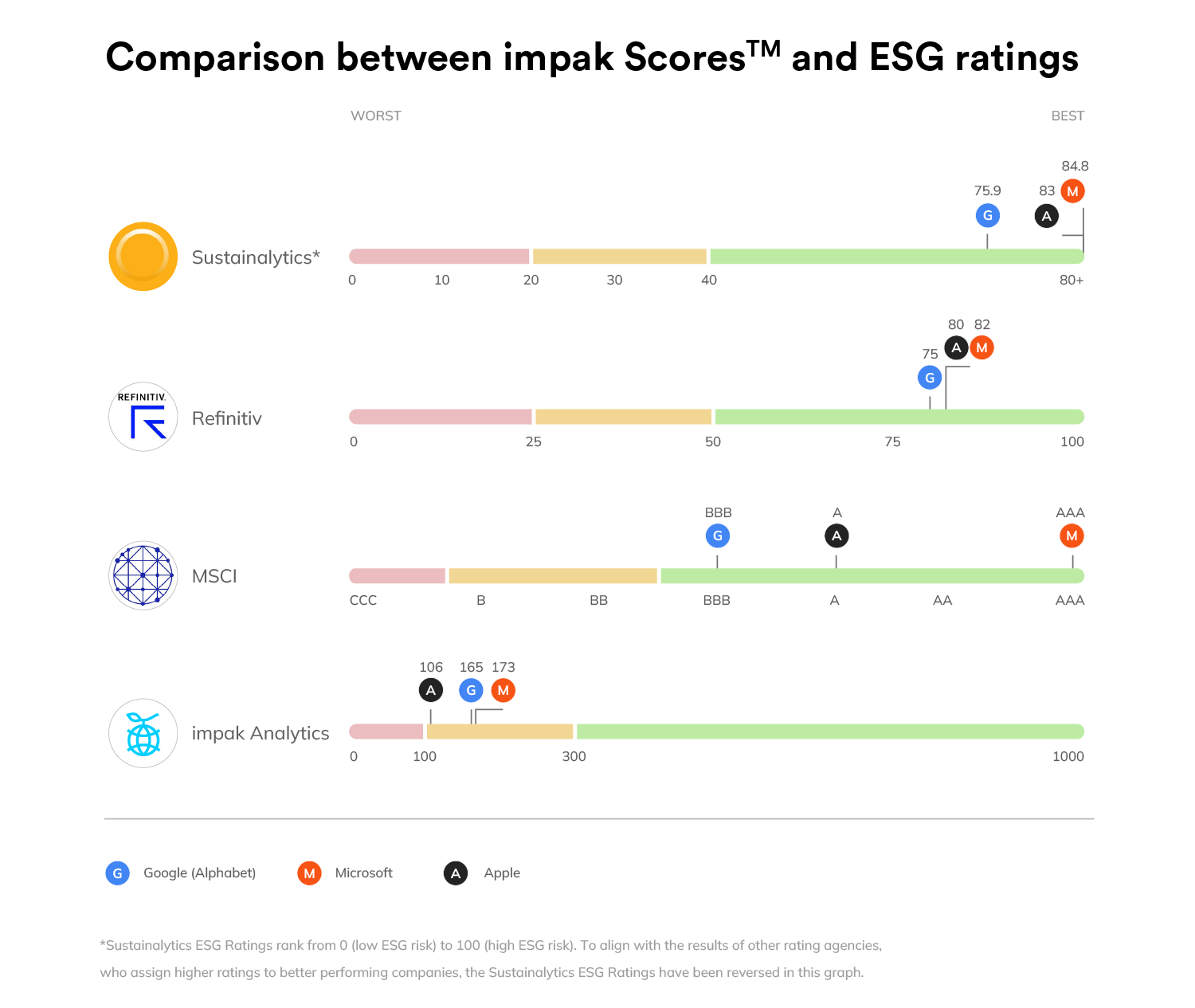
Negative impacts, mitigation and controversies
The negative impact score of Apple, Alphabet, and Microsoft is relatively low. To be clear, the score represents the mitigation of negative impacts rather than the impacts themselves. The negative impacts are rated either “A” (Act to avoid harm) or “Z” (Does or may cause harm) the lowest possible rating.
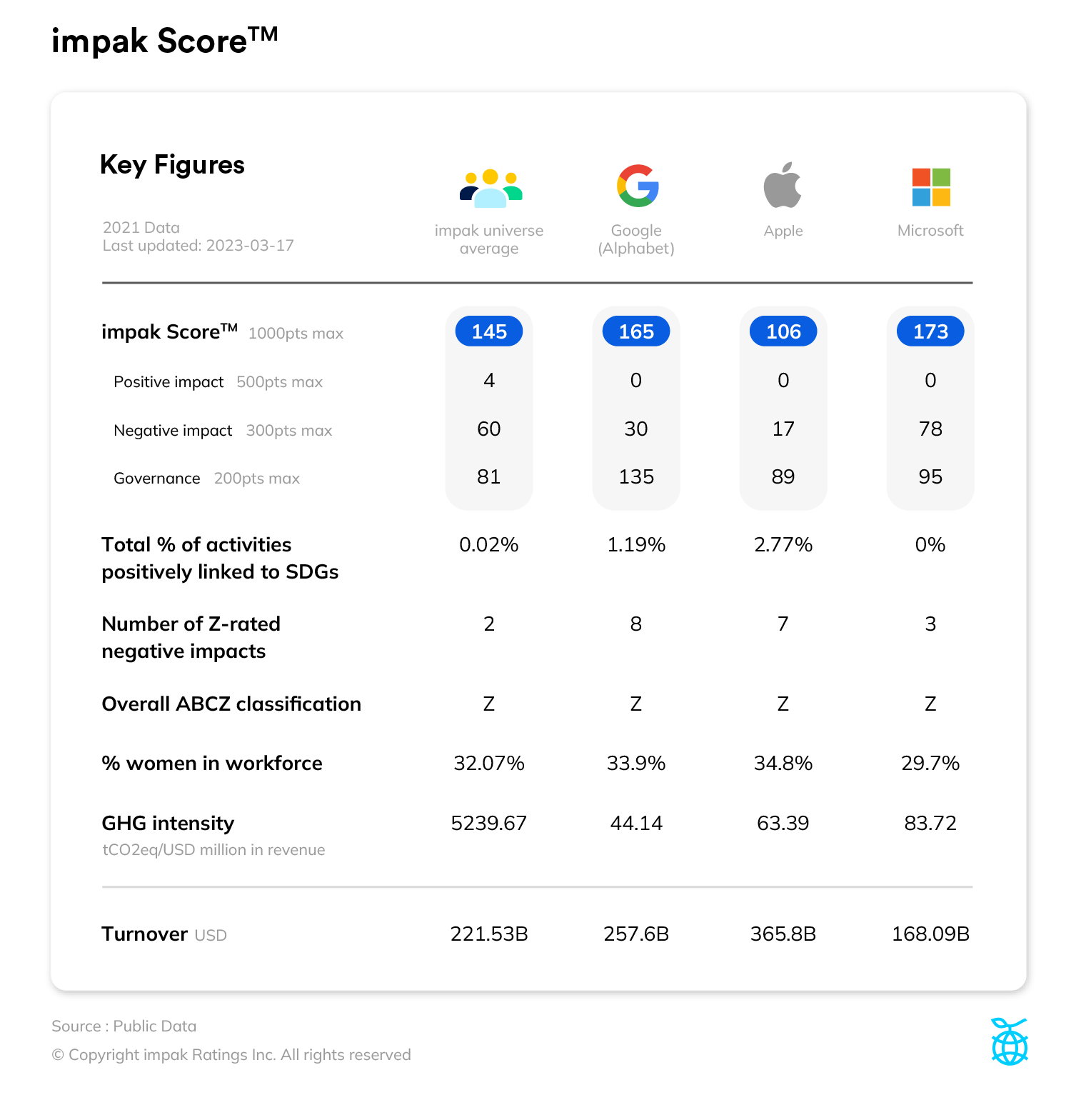
Our detailed impact statement of the companies shows that even if a negative impact has mitigation activities associated with it (in some cases there are several mitigation activities), the impact can still be rated “Z”. This can be explained by the severity and number of controversies linked to the relevant negative impact.
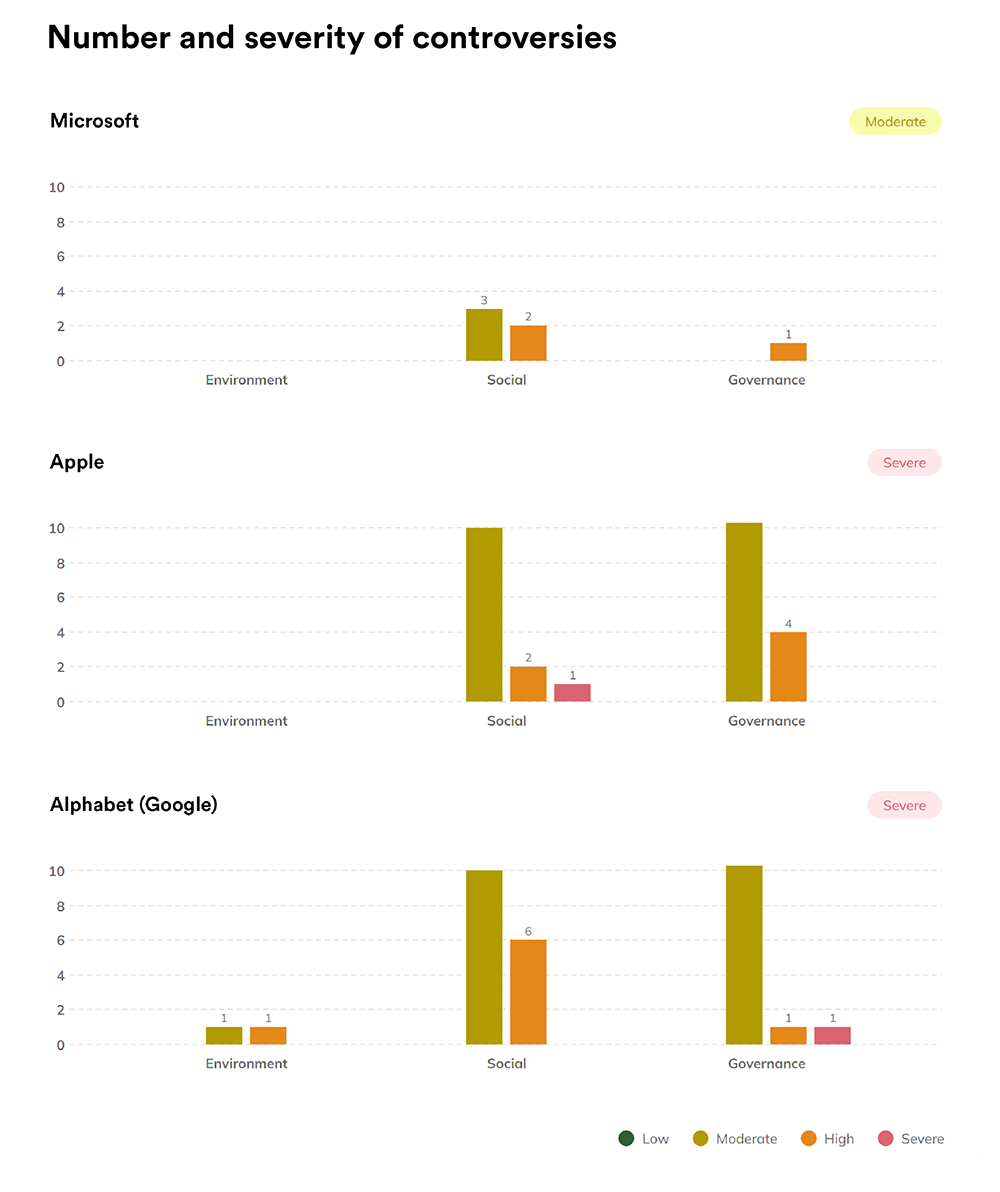
As an impact assessment needs to be considered as a whole, and from the perspective of Do No Significant Harm (DNSH) principles, a “Z”-rated negative impact will negatively affect a company’s positive impact score. We remove a pre-determined percentage of points from the positive impact score for each level of the “Z scale” based on the severity of controversies, the acknowledgement of the negative impact by the company, and the presence (or lack) of mitigation activities, ranging from 20% to 100% of points removed.
In the case of Apple and Alphabet, half of their negative impacts have received a rating of “Z”. For Microsoft, a third of its negative impacts have been rated as “Z”, but the company has no retained positive impact. Overall, Apple, Alphabet, and Microsoft all scored 0 on the positive impact score, mostly due to the severity and number of controversies related to their negative impacts.
Sector materiality
It’s no secret that there is a certain prominence of the E in ESG compared to the S, while the G is often overlooked – even if it may sometimes be the main driver of businesses’ sustainable practices. According to a BNP Paribas survey, 51% of investors found the S to be difficult to grasp and to embed in investment strategies. In fact, most investors have focused on the E as a leading ESG criterion.
Why? Environmental issues are often easier to measure, quantify, and put into models. Yet, even for the social indicators that are just as easy to measure (and thus manage), for instance diversity & inclusion and employee health & safety, we will see that none of the three analyzed companies have avoided severe controversies regarding these topics.
As for the lack of attention on the G in ESG, several examples from Apple, Alphabet, and Microsoft show that a developed sustainability governance framework can easily become a smokescreen that distorts ESG ratings. As this paper will demonstrate, effort is not always synonymous with results. As such, placing disproportionate value on effort can result in investments being channeled the wrong way.
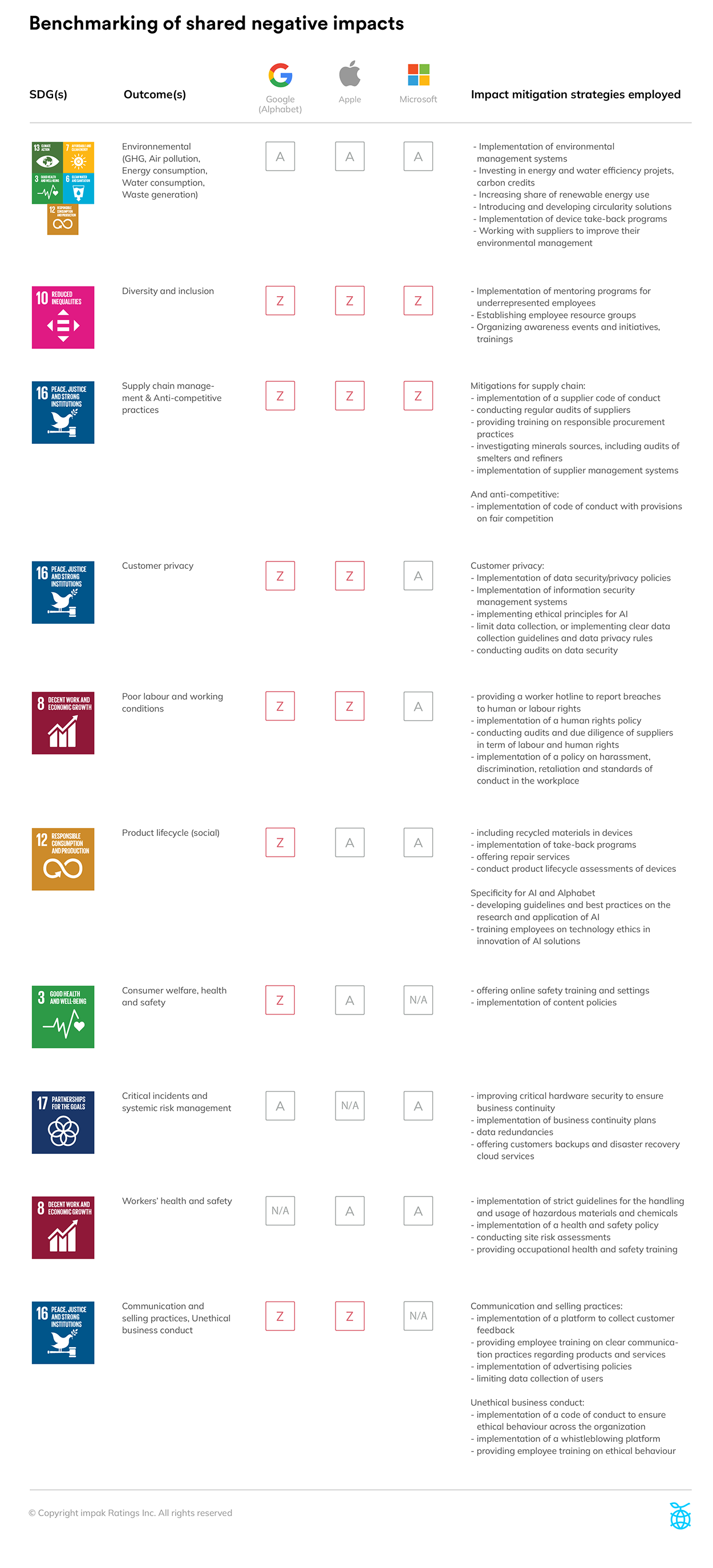
Let’s start with the E in ESG
All three companies have implemented adequate measures to mitigate their environmental impact, and invest significant capital and resources in these activities. They manage their environmental risks relatively well, with broad policies, measures, procedures and teams covering these issues. Apple, Alphabet, and Microsoft also carry out extensive advertising in relation to their performance on environmental management. For all three companies, environmental management does appear to be sufficient. They almost never have controversies related to environmental risks, other than in relation to the material issue of planned obsolescence where most, if not all, environmental-related controversies for the tech sector lie.
Putting forward the S and G
As mentioned above, the social and governance issues are where the problem really lies. A study by NYU showed that out of more than 1,750 social measures coming from 12 different evaluation frameworks, only 8% of the “S” (Social) indicators assessed the actual effects of businesses’ practices, while the vast majority (92%) based their assessments on efforts and initiatives rather than results.
Reflecting the reality of ESG, Apple, Alphabet and Microsoft are severely lacking in terms of measures addressing their social and governance impacts, especially with regard to the most material SDG targets for the sector: working conditions in both their operations and in their supply chain (many SDG 8 targets, plus SDG 3.4 and 3.9), diversity & inclusion issues (SDG 5.1 and 5.2, SDG 10.2 and 10.3), customer privacy & data security issues (SDG 16.10), business ethics (SDG 16.5) and anti-competitive practices (SDG 16.3).
It is interesting to note that, even if the sale of electronics or hardware is not especially significant for Alphabet (Nest and Pixel represent less than 10% of its revenue), it is nonetheless very much concerned by the supply chain management and conflict minerals issues.
Supply chain management
The tech sector faces strong competition in the components and electronics market, which pushes participants to regularly commercialize new generations of products, while lowering costs. This results in a combination of several risk factors: mass production, low-skilled employees, high production speed, limited regulatory framework covering working conditions, etc. Furthermore, many chemicals are used in the production of electronic components. As a result, the industry is at high risk of non-compliance with International Labour Organization conventions. The risk that these chemicals pose to human health and biodiversity is also often mishandled, and the bigger the supply chain, the bigger the supplier risk.
Suppliers
This risk cannot be overlooked. Microsoft has thousands of suppliers and Apple has 200 direct suppliers. Alphabet does not specify its number of suppliers.
Evidencing the high significance of the supplier risk, Apple, Alphabet, and Microsoft all have material controversies regarding the sourcing of gold for their production from illegal mines on Indigenous lands in the Amazon rainforest. In fact, Apple has 3 material controversies resulting from certain suppliers who fund illegal or unethical activities.
Conflict minerals and rare-earth metals
The supply of minerals which are often associated with conflicts (for instance, inputs sourced in countries or regions experiencing tense geopolitical situations, such as the Democratic Republic of the Congo) is essential to the tech industry. In places such as the DRC, armed groups often manage the extraction of minerals. This means that companies like Apple and Microsoft could be indirectly endangering both the surrounding populations and the democratic functioning of the country, by potentially financing these groups.
Even with existing policies regarding conflict minerals, both Apple and Microsoft have negative impacts earning “Z”s for the supply chain management outcome. The assessment of their mitigation activities shows that despite their efforts, the risks of inadequately screening suppliers in regions with a high risk of conflict is still too high.
Customer privacy & Data security
With the advent of the internet of things and smart-everything, companies collect an impressive amount of user data, and the related risks are significant. Just to give an idea of the scale of the problem, data breaches exposed 22 billion records in 2021. These breaches can lead to an abuse of data and the gathering of information from government agencies for surveillance purposes. Microsoft is one of many companies to have experienced a data breach in 2021.
In relation to this outcome, Apple has a negative impact rated as “Z” because it has five material controversies linked to the issue of data security. These include the allegation that Apple gave the Chinese government control over its new data storage, which contains personal data of Chinese customers.
Similarly, Alphabet has a negative impact rated as a “Z” tied to this outcome, mostly due to the severity of its related controversies. For instance, Google allegedly offered advanced AI and machine learning capabilities to the Israeli government, which could worsen the increasingly data-driven military occupation of Palestine.
Finally, Microsoft also has a negative impact linked to customer privacy and data security, but it has been rated “A”; in other words, the company has implemented effective mitigation activities and faces no severe controversies.
Unethical business conduct and Anti-competitive practices
Unsurprisingly, the tech sector is often marked by controversies related to business ethics (SDG16) and anti-competitive practices (SDG16). All members of our golden trio have negative impacts rated as “Z” for these outcomes.
In a nutshell, Apple has 14 material controversies, due to alleged monopolistic and exploitative behaviour in the context of the Apple App Store. Microsoft is currently under investigation by the European Commission for illegally bundling its Teamwork communication product with its Office Suite, while Alphabet has 12 controversies relating to monopolistic practices with regard to its advertising business. (For more details, read their impact statements here.)
Labour conditions and Diversity & inclusion
Like most large cap companies nowadays, Apple, Alphabet, and Microsoft face many challenges regarding these outcomes. Apple and Microsoft both have negative impacts rated “Z” regarding the Diversity & inclusion outcome (SDG 10), and Apple and Alphabet have a “Z”-rated negative impact relating to Poor labour & working conditions (SDG 8). The controversies involve a mix of employee harassment, union-busting tactics, sexual misconduct, gender discrimination and poor labour practices for all three companies.
The number and the severity of controversies surrounding Apple, Alphabet and Microsoft’s activities call into question the effectiveness of their sustainability governance framework and mitigation strategies. Furthermore, despite the importance of the aforementioned social and governmental issues, which are clearly all material to the tech sector, ESG ratings do not seem to reflect this brutal reality for these three companies. This may be where a big part of the problem lies: the materiality of controversies. Through the perspective of the double materiality approach, the materiality and severity of controversies are based on the impact they have on stakeholders, as well as the stakeholders’ level of vulnerability.
Let the sunshine in
Now let’s talk about positive impact. The iS2 methodology uses a 5-step process to select the positive impacts of a company.
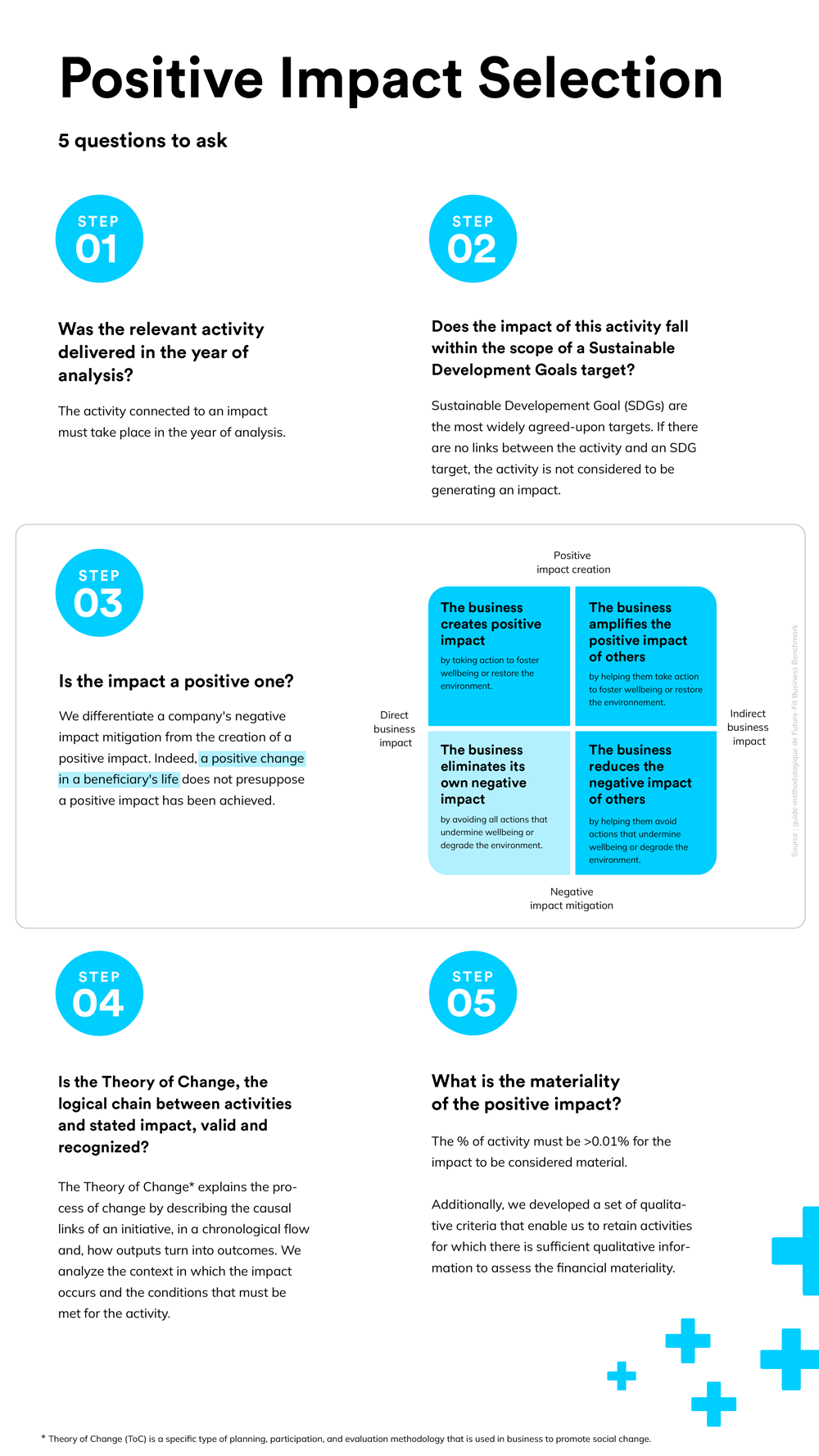
Apple has one retained positive impact linked to the SDG 10 – representing 2.77% of its activities (it supports diverse entrepreneurs through the implementation of a supplier diversity program) and five positive impacts that have been labeled “considered” only.
Alphabet has two retained positive impacts: the first one is linked to the SDG 8 and represents 0.29% of the company’s activities (it supports emerging technology businesses through investments in Google’s portfolio, along Google for Startups Accelerator: Climate Change). The second one is linked to the SDG 10 and represents 0.9% of Alphabet’s activities (it supports Black entrepreneurs in the U.S through the implementation of a supplier diversity program).
As mentioned earlier, according to impak’s methodology, due to the large number of negative impacts rated “Z” for both Apple and Alphabet (mostly related to material and severe controversies, see the Negative impact and controversies section) 100% of the points attributed to each company for its positive impact score were deducted, and, as such, the final positive score for each company is 0.
This decision may appear extreme for some, but the reality is that the positive impact scoreTM has to be impacted by what is going on in the negative impact section. Taking this example to the extreme, imagine a green energy producer using modern slavery to produce its energy. Showing an unimpacted positive impact score could mislead an investor into believing that XYZ company is a force for good, but such a company could not possibly be rated “B” (benefit stakeholders) or “C” (contribute to solutions) if it does not properly mitigate all its negative impacts. Here, the depth of information provided by our impact statements is key for both investors and issuers to acknowledge and address negative impacts and controversies.
Finally, Microsoft has five positive impacts that have been considered but none that were retained because, in each case, one of the five criteria was not met.
The key word here is “retained”. Apple, Alphabet, and Microsoft all appear to have numerous activities with positive outcomes. To name just a few: Apple offers solutions for digital health through the use of ICT, such as the Apple Watch, and supports educational initiatives to expand learning opportunities in communities that are historically underrepresented or under-resourced in technology. Microsoft provides free-of-charge tools for organizations to identify and quantify water-related risks and reduce water usage, and implements an AI program for disaster recovery efforts. Alphabet helps to increase the employability of underserved populations by providing training and internship programs in the ICT field, and develops a commercial app for sustainable commodity sourcing. This seems positive, but what is the actual scope covered by these initiatives?
All these activities are “considered” in the impact analysis, but not “retained”. Why? Because the ultimate criterion to retain a positive impact is that the activity must reach the financial materiality threshold (step 5 in the infographic), i.e the percentage that this activity represents in the whole company. The threshold is >0.01% of the company’s activities.
Green Bonds, Sustainable Bonds and Climate Funds
It would be remiss of us to talk about positive and negative impacts without mentioning green and sustainable bonds. At the end of Q3 2022, USD3.5 trn have been issued in “sustainable bond labels”. Like many large cap companies, Apple and Alphabet have decided to join the party and have issued green/sustainable bonds. But what is the real impact of these bonds?
Since Apple’s first green bond issuance in February 2016, the company has issued $4.7 billion, with $3 billion green bonds allocated to this day. Although it does not provide the entire breakdown of its allocation, its 2021 Green Bond Impact Report shows that the bonds mostly support Apple’s own mitigation activities.
For its part, Alphabet issued “$5.75 billion in sustainability bonds […] the largest [sustainable] bond issuance by any company in history at the time [2020],” with full allocation occurring in 2022. In its 2022 Sustainability Bond Impact Report, the company clearly outlines the allocation of funds, showing that 90% finances Alphabet’s own mitigation activities and projects (i.e preventing food waste in campus cafeteria, achieving LEED certification for office buildings, developing energy efficiency projects for Alphabet’s data center campuses, etc.). It is understood that less than 9% of the allocation can be attributed to positive impacts (i.e. affordable housing, loans to Black-owned SMEs and loans to SMEs in response to COVID-19).
Compared to Apple and Alphabet, Microsoft is a breath of fresh air, with its USD1 billion Climate Innovation Fund, which has the potential to have a positive impact. The fund focuses on funding emerging climate technology solutions that (i) have early commercial traction and need capital to scale-up, or (ii) need financial support to bring existing climate solutions to scale.
So why did impak consider Apple and Alphabet’s bonds and Microsoft’s fund as potential positive impacts rather than an actual one? It is often difficult to distinguish a clear contribution to a positive impact from the mitigation of a negative impact. As such, the quantitative information was not sufficient enough to assert that these positive impacts have reached our financial materiality threshold of 0.01%. Therefore, in order to provide an accurate impact assessment of a company, activities must be labeled as they are, in this case, potential positive impacts. For the moment, Apple and Alphabet’s green bonds mostly cover the implementation of their mitigation activities, which tells more about their risk management strategies, than their actions to create positive impact.
Conclusion
The world of extra-financial reporting and ratings is a wild one. Financial market participants are getting more sophisticated everyday and regulations are slowly but surely building a framework to work with. Looking at Apple, Alphabet and Microsoft through the lens of the impact analysis – which includes the double materiality approach and the analysis of both the positive and negative E, S and G impacts – they fail to demonstrate that they are agents of change… just yet. With a respective impact Score™ of 106, 165 and 173 out of 1,000 points, they are very far from their top ESG ratings.
We are at a pivotal moment for the E, S and G assessment and as shown, the market has all the tools, theories and data to prevent further misleading ESG ratings regarding large cap companies – the most damaging ones in terms of ineffective sustainable investing.
With the global triple crisis, economic, sanitary, and environmental, that we are currently living in, an economic paradigm shift is inevitably underway. In the United States alone, Treasury Secretary Janet Yellen highlighted a five-fold increase in annual billion-dollar disasters in the last five years.
It is only with the right regulations, tools, and data that financial market participants will be able to benefit from long-term investments while contributing to a positive impact economy, one that re-establishes the lost, but fundamental, link between the well-being of living beings and the economy.
Behind an impact assessment and scoring system
An impact assessment is complex and the industry standards which only look at outcome indicators are simply insufficient, as part of this complexity is lost. With this in mind, impak Analytics has developed the impak iS2 methodology and impak Score™. Ratings such as the impak Score™ can embrace that complexity, providing a holistic tool backed by a human eye to track the evolution of impact through time and, most importantly, benchmark investments.
impak’s methodology allows us to have a 360-degree view of the positive and negative social and environmental, negative and positive impacts of organizations of any size and in any sector (unlike ESG analysis which focuses on negative impacts alone) thus enabling efficient comparison and transparency. This methodology results in two components: the impak Score™, described below, and the impact statement, a complementary and detailed qualitative assessment of the company’s impact, all in alignment with the UN’s 17 Sustainable Development Goals (SDGs) and based on the Impact Management Project (now IMP norms, hosted by Impact Frontiers). This comprehensive information allows investors to understand and benchmark their performance, enabling quicker data-driven decision-making, based on the social and/or environmental impacts of companies and portfolios.
As mentioned above, the methodology is based on the IMP norms, most notably on the IMP criteria. The iS2 methodology uses 16 criteria divided into five categories drawn from the IMP’s impact dimensions, which go as follows:
The WHAT or impact type: What outcome(s) do business activities drive? How important are these outcomes to the people (or planet) experiencing them?
The WHO or impact beneficiaries: Who experiences the outcome? How underserved are the affected stakeholders in relation to the outcome?
The HOW MUCH or impact magnitude: How much of the outcome occurs— across scale, depth, and duration?
The CONTRIBUTION: What is the enterprise’s contribution to the outcome, accounting for what would have happened anyways?
The RISK: What is the risk to people and the planet that impact does not occur as expected?
The impak Score™ complements the impact statement of a company. It ranges from 0 to 1,000, with a maximum of 307 data points from a total of 3,854 data points collected through impak’s data collection process. Our data collection process can collect from either public or private issuers with the same level of precision and efficiency.
The score is primarily based on the ZABC impact classification originally proposed by IMP – “C” being the most advanced type of impact organization, with the highest performance both in mitigating its negative impact and generating positive outcomes. The more an organization performs similarly to a C-type company for each selected criterion, the more points it earns scores.
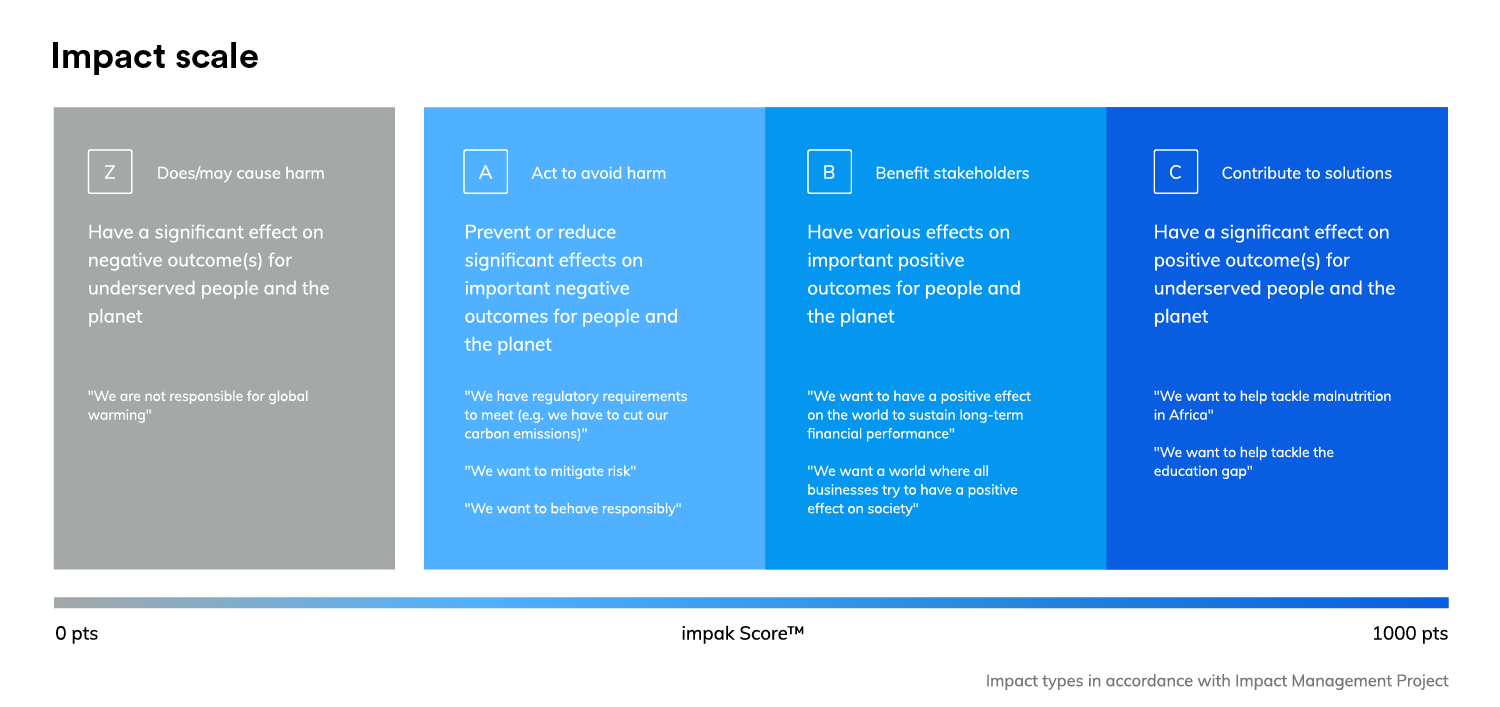
In other words, the closer an organisation’s impak Score™ is to 1,000 points, the more likely it is to be a C-type company.
The impak Score™ rates the capacity of a company to generate positive impacts and mitigate its material negative impacts at a given time This capability makes it unique in the market and enables the ranking of companies based on their impact, in addition to allowing for objective-setting and tracking. It summarizes the context behind the numbers, which is key in impact analysis in order to gain an accurate understanding of the ESG factors, as we have seen with the analysis of Apple, Alphabet and Microsoft. As such, one dollar invested in a company with a comparatively higher score will have more chance of producing a positive impact than one dollar invested in a company with a comparatively lower score.
This case study retained your intention? Have a look at our Unilever’case study here
About impak Analytics
impak Analytics’ mission is to help participants in the financial market make more sustainable decisions by providing them with assessments that go beyond ESG and include both the negative and positive impacts of their assets, whether listed or private.
impak offers human-augmented transparent, comparable, measurable, and rigorous environmental and social data (impact data). The goal is for money managers to integrate reliable impact data into their decision-making processes in order to enable capital to finance a more positive impact economy – one that can handle the social and environmental challenges we’re currently facing.
To this end, impak has developed several assessment tools and products like the impak ScoreTM and the impact statement. These tools, which complement each other, allow for data contextualization, double-materiality analysis, and alignment with new regulations (EU Taxonomy, SFDR, Climate Strategy, etc.).
For example, impact statements allow our clients and partners in the financial sector to better manage their internal and external risks, and to identify opportunities for having a positive impact, essential factors in gaining a long-term perspective on climate change and impact alpha.
We represent the second generation of non-financial rating agencies, avoiding the pitfalls of first generation ESG ratings and ensuring a tangible change in the economic paradigm.
Case study
Written and coordinated by Stéphanie Bernier-Monzon – Communications Manager
Contributors
Tammy Tran – Impact Analyst, tech sector
Étienne Gendron – Impact Analyst, tech sector
Boris Couteaux – VP, Business and Product Development
Proofreaders
Leizhen Chen – Impact Analyst and Senior Proofreader
Laura Hegarty – Impact Analyst and Senior Proofreader
Gwendoline Dane – Junior Impact Analyst and Proofreader
Wynnie Zhao – Junior Impact Analyst and Proofreader
Design
Hugo Caron – Design Director
Media Contact
US-CAN
Stéphanie Bernier-Monzon stephanie.bernier-monzon@impakanalytics.com +1 438 886 8796
EUROPE
Robin Placet robin.placet@impakanalytics.com
+33 6 26 81 20 54
You may also like

Why agribusiness giants won’t save the world from hunger.
By impak Analytics
Why single materiality is not good risk management
By impak Analytics